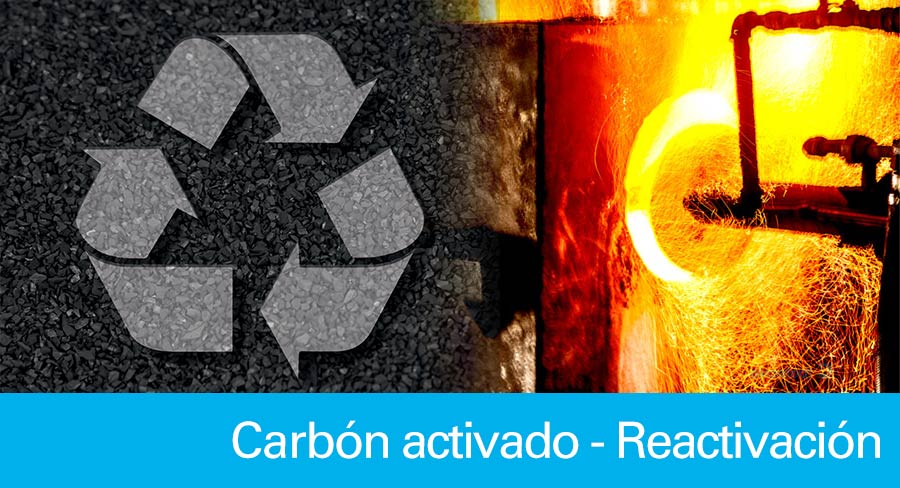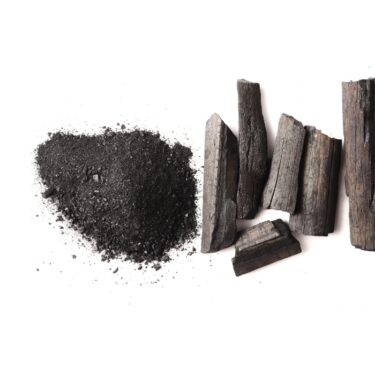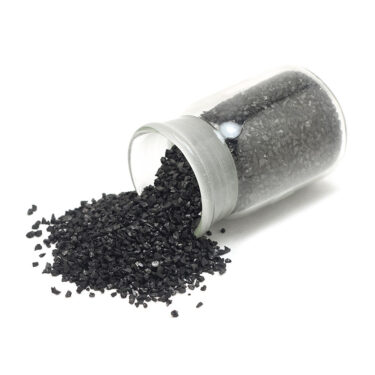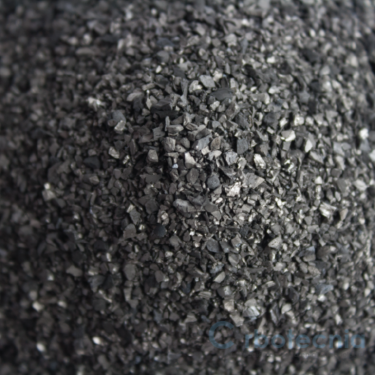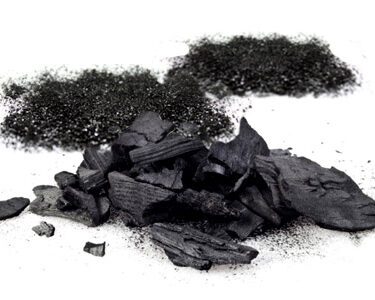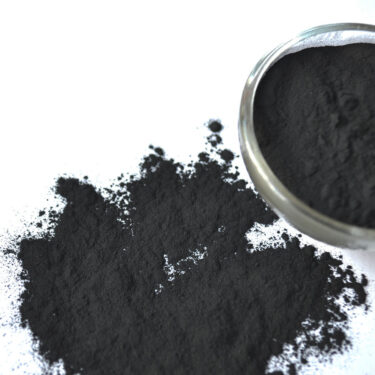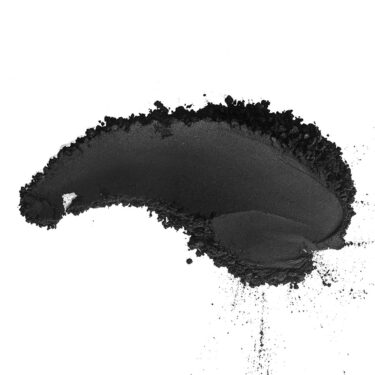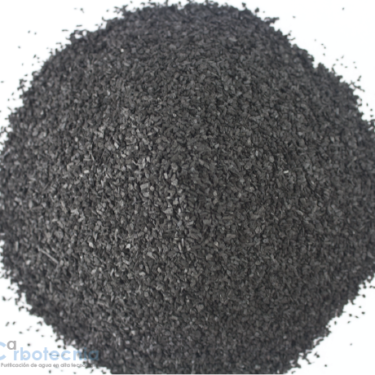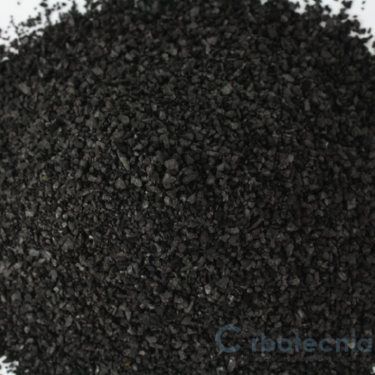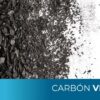Reactivation of spent activated carbon
Activated carbon is a highly porous material used in numerous applications to purify liquids and gases. Its ability to adsorb a wide range of compounds makes it an essential component in water filtration systems, wastewater treatment, and various industrial processes. However, over time, activated carbon is depleted and loses effectiveness, leading to the need for reactivation or replacement. Here we explore the activated carbon reactivation process and the benefits associated with this practice.
Natural adsorption process of an activated carbon
The adsorption process consists of a solid trapping a certain molecule of a fluid (liquid or gas) on its walls. The solid is called adsorbent, the process, adsorption, and the trapped molecule, adsorbate.
Activated carbon is a covalent adsorbent. As such, it adsorbs molecules with a covalent tendency, which is the case for most organics. It differs from other types of carbon because it is more porous and because it is formed by graphitic plates in which the carbon atoms are bonded together in an orderly fashion. This order makes them less reactive (or more stable) than the atoms that form amorphous carbons.
The adsorption process involving activated carbon is due to one of the types of Van der Waals forces, called London dispersion forces, which occur between a covalent adsorbent and a covalent adsorbate. This kind of adsorption is called physical adsorption.
Physical adsorption does not cause a change in the chemical structure of the atoms and molecules involved. Therefore, it is reversible. If the adsorbate retained is volatile, a sufficient rise in temperature causes it to be released from the activated carbon. This temperature depends on the volatility of the adsorbate. Both it and the carbon remain in their original state, and the procedure is called reactivation. If the adsorbate is not volatile, when the temperature is raised to a certain level (usually above 300°C), it undergoes pyrolysis. That is, it loses its hydrogen and oxygen atoms and is transformed into amorphous carbon. If the temperature is further increased, the resulting amorphous carbon reacts with the furnace gases and is converted to carbon dioxide. Upon gasification, it frees the surface area of the graphitic plates. In this way, a reactivation also occurs.
As mentioned in previous paragraphs, the graphitic plates constituting the activated carbon are less reactive than amorphous carbon, so they do not gasify as long as the temperature and time of the reactivation process do not increase more than they should.
When inorganic compounds have precipitated on an activated carbon, they cannot be removed by increasing the temperature. However, it is possible to remove them by other methods. One of them is by dissolution in an acid solution.
Different reactivation methods are described below. They are possible not only because of the stability of its graphitic plates, but also because activated carbon is not affected by aqueous solutions over the entire pH range.
Although both granular activated carbons (GAC) and powdered activated carbons (PAC) can be reactivated, until now, reactivation of the latter has been profitable in very few cases, due to the difficulty in handling the powders, which are usually smaller than 200 mesh.
The cost-effectiveness of the CAG reactivation process depends on the mechanical strength of its granules. The lower it is, the higher the percentage of material loss due to breakage increases.
It is worth mentioning that an activated carbon that is removed from the process in which it was used is called “spent carbon”.
What is the reactivation of spent activated carbon?
The reactivation of activated carbon involves its thermal treatment at high temperatures, generally between 600 and 900 °C, in the absence of oxygen. This process burns the impurities adsorbed on the surface of the carbon without significantly deteriorating its porous structure. Thus, the carbon can be reused in multiple cycles, which reduces the need to produce new activated carbon and minimizes waste generation.
Benefits of coal reactivation
Environmental sustainability
Reactivation is a sustainable practice that contributes to the circular economy. By recycling activated carbon, we reduce the demand for raw materials and reduce the amount of waste produced. This process helps conserve natural resources and reduces the environmental impact associated with the extraction and processing of new materials.
2. Cost-effectiveness
The reactivation process is generally more economical than the production of new activated carbon. Although reactivation requires investment in infrastructure and energy, the cost per use of activated carbon decreases by extending its useful life. This translates into significant savings for industries that rely on large volumes of activated carbon.
3. Improved efficiency
Through reactivation, the adsorptive capacity of the activated carbon can be restored to its initial efficiency. This ensures that the reactivated carbon can continue to perform at optimum levels, providing consistent results in critical applications such as drinking water treatment and industrial processes.
4. Carbon footprint reduction
The reactivation process reduces the carbon footprint of operations using activated carbon. By reducing the frequency of replacement and transportation of new material, CO2 emissions associated with these activities are reduced. This is especially important in regulated industries committed to sustainability objectives.
Types of activated carbon reactivation
Thermal reactivation.
It is the most widely used reactivation method. It is carried out in furnaces similar to those used to thermally activate coal. The most common kilns are rotary kilns and multi-stage direct heating kilns (through the introduction of combustion gases). Typically, reactivation is carried out at temperatures between 500 and 800°C. The oxidizing capacity of the atmosphere inside the furnace is limited by means of water vapor. The volatile compounds are released from the GAC and the non-volatile compounds pyrolyze and gasify.
Steam reactivation
This process is carried out in the same equipment in which the GAC is applied. It consists of circulating steam through the coal bed, usually in a downward direction, so that condensate does not accumulate. The steam causes volatile organic molecules to be released from the carbon.
This reactivation method is applied in the recovery of solvents contained in air streams. The GAC is subjected to alternating adsorption-desorption cycles. In the former, the solvent is retained until the carbon is saturated. In the second, the solvent is desorbed, and the mixture of solvent and water vapor is separated by decantation or by distillation, depending on whether they are miscible or not.
The higher the pressure of the vapor used to reactivate the GAC, the higher its temperature will be, and therefore it will be able to desorb less volatile compounds.
Reactivation with hot gases
It is the same as the previous one, but it does not use water vapor but some other gas. In the case of some scientific studies at laboratory level, where reactivation is required without the interference of any oxidizing gas, desorption is carried out by means of an inert gas that is heated indirectly. This gas can be nitrogen. When reactivation at a lower temperature is required to avoid affecting the adsorbate, reactivation can be carried out under vacuum.
Reactivation with acid.
Inorganic salts precipitating in the GAC are not removed by thermal reactivation. However, they can be eliminated by dissolution in an acid solution.
A common case is lime precipitation which is applied to soften water before passing through the GAC. Another is the precipitation of carbonates and other salts present in waters with a fouling tendency. When salt precipitation is high, the coal takes on a grayish or whitish color as it dries (this color is not noticeable if the coal is wet).
This type of reactivation is carried out with hydrochloric acid, since it is the strongest acid with the greatest capacity to dissolve inorganic compounds. The solution of about 5% by weight is prepared, and the charcoal is flooded into it. The dissolution process of calcium salts is slow. The time varies depending on how embedded the charcoal is, but may take a few hours. For faster processing, the solution is heated to 60 – 70ºC.
A suitable reactivation returns the charcoal to its original black color.
Reactivation by pH modification in aqueous solution
When the retention capacity of a specific adsorbate depends on the pH value, this condition can be exploited to desorb it. For example, the adsorption of phenol is highly dependent on the pH of the solution in which it is found. As the pH increases, its adsorption decreases to such a degree that desorption can occur. A coal saturated with this compound can be reactivated by a 4% soda solution.
Inorganic compounds that have precipitated on activated carbon can also be removed by flooding the carbon in a solution with the pH that produces their dissolution.
The reactivation of activated carbon by pH modification in aqueous solution has very few applications.
Biological reactivation
Biological reactivation of GAC occurs naturally in the treatment of water with a relatively high content of biodegradable organic compounds. This is the case, for example, of tertiary wastewater treatment.
Bacteria growing on the surface of the charcoal feed on the adsorbed biodegradable matter and convert it into carbon dioxide and new bacteria. The latter are eliminated by backwashing the GAC. When activated carbon operates in this way, it is called biological carbon.
A CAG can also be biologically reactivated when it has been removed from the adsorption process in which it was applied, although this process is rare.
Considerations and challenges
Despite its benefits, activated carbon reactivation is not always applicable. The feasibility of this process depends on the nature of the adsorbed impurities and the type of activated carbon used. In addition, rigorous control is required during the reactivation process to avoid material degradation and ensure effective removal of impurities.
More information at: Can spent activated carbon be regenerated? | Reactivation (carbotecnia.info)
Share:
If you need more information, please contact us.
Some products that may interest you
-
AA-3 Activated carbon to reduce color and flavor in tequila and other distilled spirits
Add to quote -
Micro K Coconut shell activated carbon
Add to quote -
Micro 4 LF Coconut shell activated carbon free of fines
Add to quote -
Megapol C – Wood powder activated carbon
Add to quote -
Megapol E – Wood powdered activated charcoal
Add to quote -
Micropol 4 200 – Coconut shell powdered activated carbon
Add to quote -
Mega – Wood granular activated carbon
Add to quote -
Gama L – Lignite coal mineral activated carbon
Add to quote

